We are proud to be a part of the campus and local communities. We sometimes visit local schools, such as Del Mar Pines Elementary, Toler Elementary, and Allen Elementary, to perform science demonstrations. We help students of all education levels get exposure to science. Of particular note is the PHYS 133 class which allows undergraduate students the opportunity to take part in real scientific research.
One of our oldest outreach efforts is helping with Science Day at Del Mar Pines Elementary. Below are links to pictures from some of the years we’ve attended!
One of our oldest outreach efforts is helping with the annual Science Day at Del Mar Pines Elementary. Below are photos from our 2004 visit
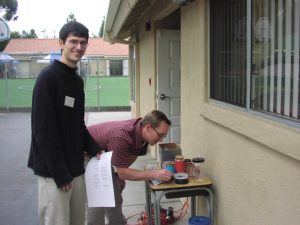
Todd and Ryan practice their performance.
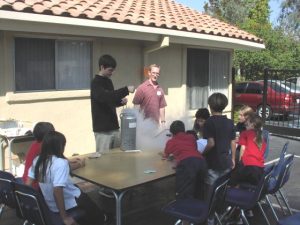
Demonstrating the cryopump
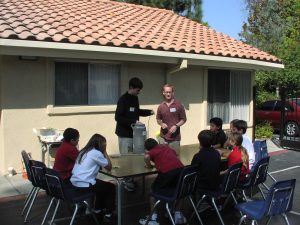
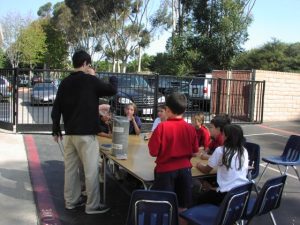
Showing off the cryopump
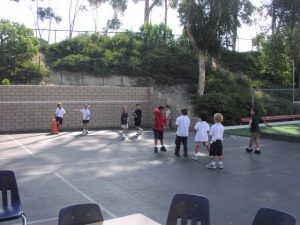
The game with no rules
One of our oldest outreach efforts is helping with the annual Science Day at Del Mar Pines Elementary. Below are photos from our 2006 visit
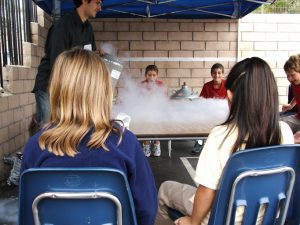
Graduate Student Ryan Baumbach demonstrates that liquid nitrogen boils at room temperature
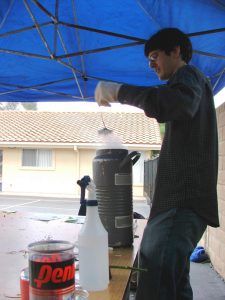
Ryan freezes a flower (which becomes very brittle)
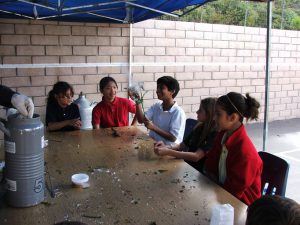
Students examine frozen flowers
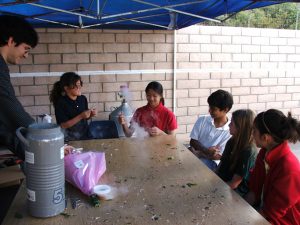
Each student getsthe opportunity to smash their own frozen flower
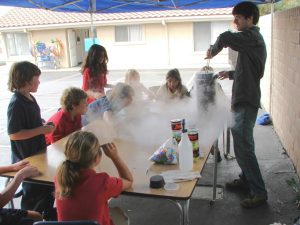
Ryan demonstrates flash-freezing of an orange using liquid nitrogen
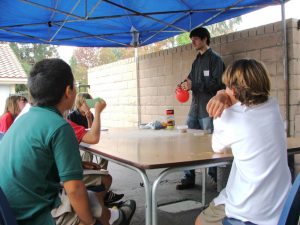
Ryan prepares to demonstrate the effect of liquid nitrogen on a balloon
One of our oldest outreach efforts is helping with the annual Science Day at Del Mar Pines Elementary. Below are photos from our 2007 visit
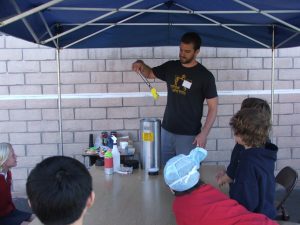
Graduate Student Colin McElroy demonstrates the effect of liquid nitrogen on a balloon
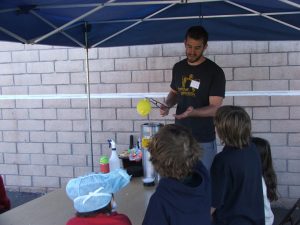
As the balloon warms the air inside it re-expands
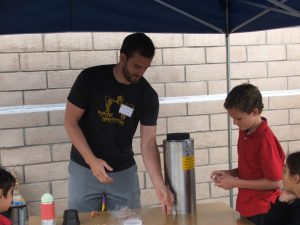
Colin prepares to demonstrate the effect of liquid nitrogen on polymers, such as rubber bands
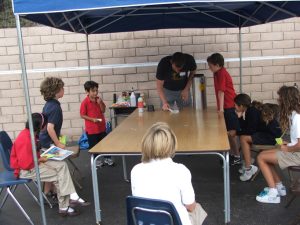
Colin freezes a rubber band

Students ask questions about liquid nitrogen
One of our oldest outreach efforts is helping with the annual Science Day at Del Mar Pines Elementary. Below are photos from our 2012 visit
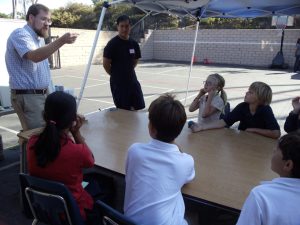
Postdoctoral Researcher Dr. Benjamin White illustrates how liquid nitrogen temperatures can drastically change the physical properties of various items. In this photo, a rubber band was used. Some of the students expect it to explode.
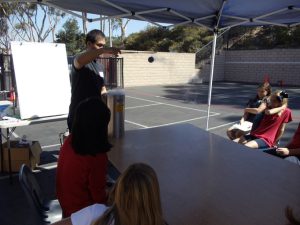
Graduate student Kevin Huang releases a liquid nitrogen cooled raquetball. This time the students create some extra safety distance.
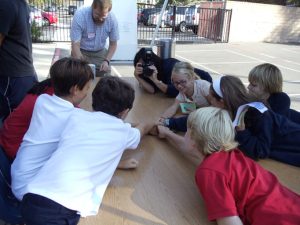
After warming up, the raquetball recovers it original properties. The children block the view of the raquetball in the image
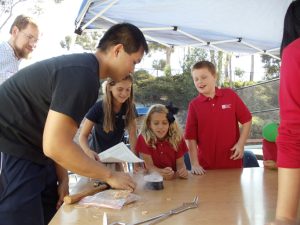
A YBa2Cu3O7-δ pressed pellet, when cooled to liquid nitrogen temperatures, enters the superconducting state. One of the consequences of superconductivity is the Meisner effect, the exclusion of all magnetic fields from the pellet.
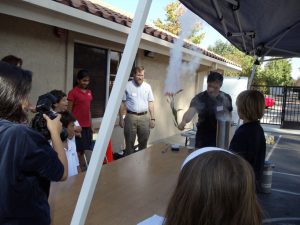
A local flower has also been cooled to liquid nitrogen temperatures and is about to collide with the table.
One of our oldest outreach efforts is helping with the annual Science Day at Del Mar Pines Elementary. Below are photos from our 2013 visit
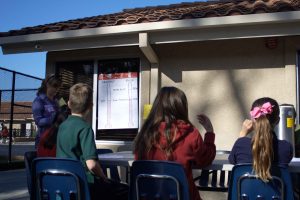
Graduate student Veronica Burnett discusses the various temperature scales, reinforcing just how cold liquid nitrogen is.
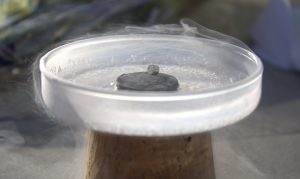
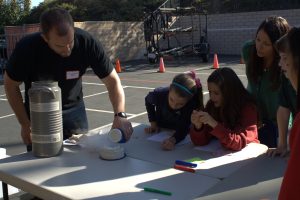

Graduate student Colin McElroy demonstrates and discusses the Meissner Effect, one of the defining characteristics of a superconductor.
 A cold tennis ball is delicately handled by one of the students.
A cold tennis ball is delicately handled by one of the students.
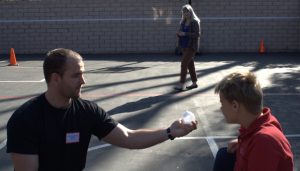
A balloon collapses on itself as it is cooled to liquid nitrogen temperatures.
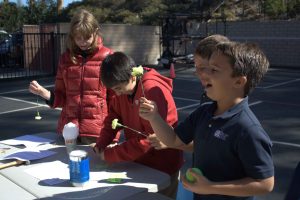
Some nearby flowers were harmed during the course of this year’s Science Day.
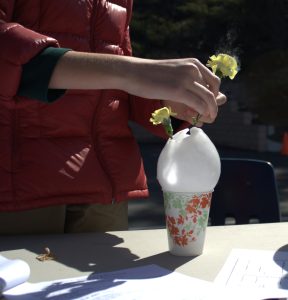
Some survived and complemented nicely the ice sphere made by a water filled balloon being exposed to liquid Nitrogen.
We participated in Science Night at Toler Elementary School in Mission bay in 2006. Below are photos from that event.

Ryan discusses some basic principles of condensed matter physics and materials science with the students
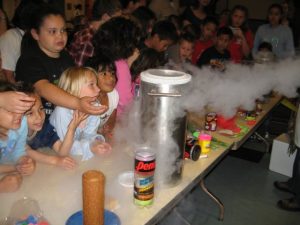
We introduce the students to liquid nitrogen. Hopefully it’s a lasting relationship.
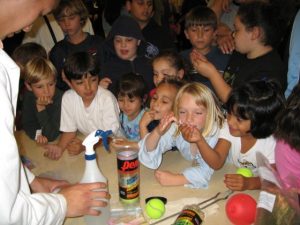
The students marvel at the amazing freezing power of liquid nitrogen.
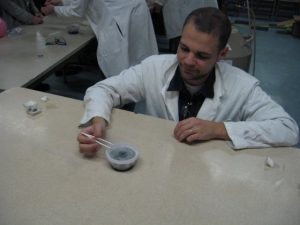
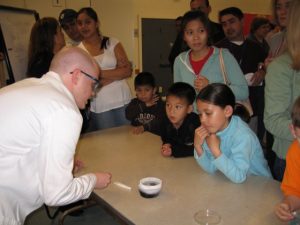
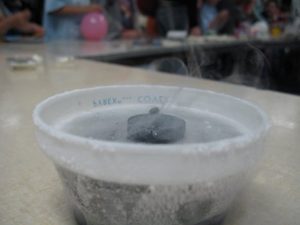
Neil and Johan, two graduate students from Professor Di Ventra’s research group at UCSD, demonstrate magnetic flux expulsion and pinning in high temperature superconductors. The students are more interested in the liquid nitrogen itself.
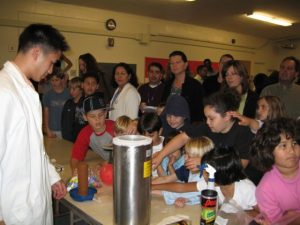
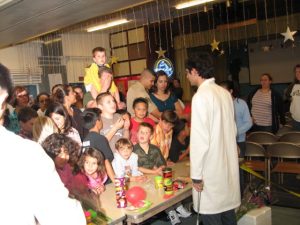
Keith and Ryan demonstrate the ability of liquid nitrogen to freeze things. Students invariably want to see frozen paper. It is usually quite a disappointment since the properties of paper at 77 K are almost identical to its properties at room temperature. The students recover their interest when tennis balls, flowers, and balloons are frozen and shattered.
Allen Elementary School of Bonita, CA invited our group to give a special presentation on science for their 5th grade students in 2008 and 2009. Below are pictures from our 2008 event.
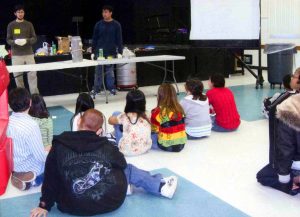
Graduate Students Ryan Baumbach and Kevin Huang entertain students with scientific demonstrations
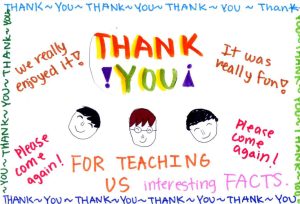
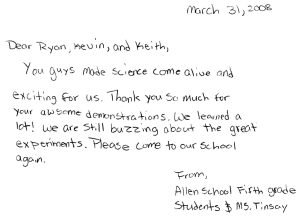
Middle and High School students from around San Diego come to participate in the Young Physicists Program run by the Physics Department. Below are pictures from our participation in this program in 2010
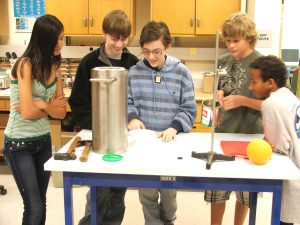
A group of students enjoying the effects of liquid nitrogen
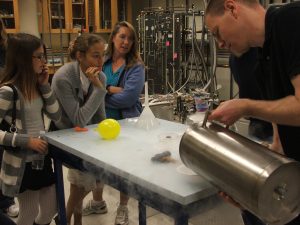
James Hamlim prepares his next demonstration in front of a group of students and adults
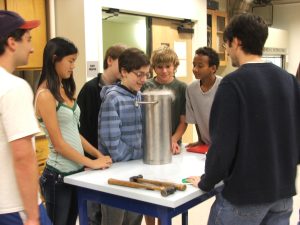
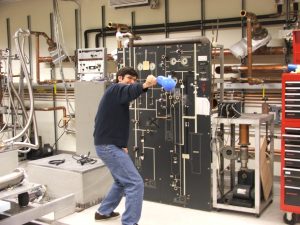
Ryan Baumback demonstrates the vaporization of liquid nitrogen in a balloon. Do not try this without the supervision of a condensed matter physicist
The ENLACE summer research program at UC San Diego aims to encourage the participation of high school and university students in research in the sciences and engineering, while promoting cross-border friendships between Latin America and the United States. The program is 7 weeks in length, during which time participants live and participate in research at the UC San Diego campus.
More details can be found at http://resilientmaterials.ucsd.edu/ENLACE
In 2022, two university students from the ENLACE Program, Daniel Ormart and Kiomy Esparza, were assigned to complete a project with us at the Maple Lab. Since we as a lab specialize in sample growth, Kiomy and Daniel not only grew their own superconducting crystals, but they also performed their own magnetization measurements using some of our specialized lab equipment. Here, the students synthesized a high-temperature superconductor (Y1−xPrx)Ba2Cu3O7−δ , a doping of famous compound YBCO, notably the first discovered high temperature superconductor, through a growth process called flux growth. Kiomy and Daniel learned firsthand how to effectively and efficiently prepare all the powdered constituents of a flux growth, how to use programmable lab equipment such as our small box furnace and our Quantum Design Dynacool, and how to analyze the data of a superconductive phase transition. Photos of their time here are shown below.
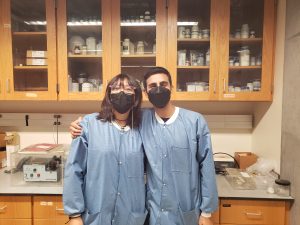
Kiomy and Daniel in the lab.
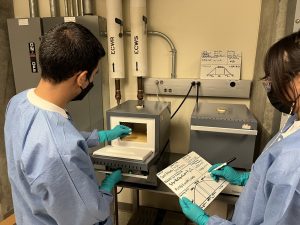
Kiomy and Daniel seen placing a crucible inside of our small box furnaces to fire BaCO3 powder to dry the powder and prepare to mix it with other PrYBCO constituent powders for their flux growth.
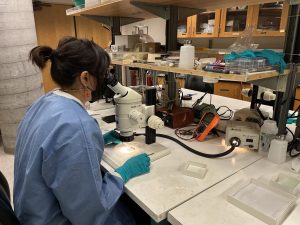
Kiomy seen analyzing and harvesting PrYBCO crystals after their synthesis is complete
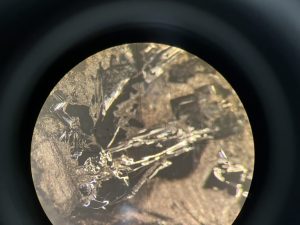
One of the (many) large PrYBCO crystals that formed inside of the excess flux.
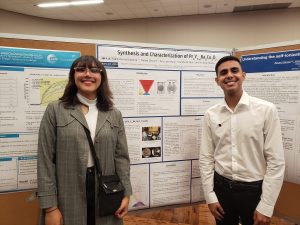
Kiomy and Daniel present their work at the ENLACE poster session.
In 2023, two highschool students from the ENLACE program, Astrid and Marisol, were assigned to complete a project with us in the Maple Lab. Since we specialize in crystal growth, they prepared URu2-xOsxSi2 samples by tetra-arc melting. Below are some photos from their time with us.
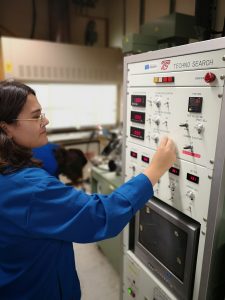
Astrid adjust the hearth speed of the Terra-arc furnace.
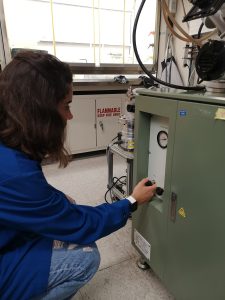
Marisol purges oxygen from the tetra-arc by pumping and filling the chamber with argon.
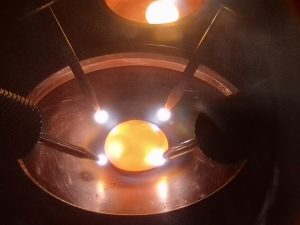
The elements being melted by arcs from the four electrodes.

The students observe the melted alloy after arc-melting.
- Del Mar Pines Elementary
-
One of our oldest outreach efforts is helping with Science Day at Del Mar Pines Elementary. Below are links to pictures from some of the years we’ve attended!
2004One of our oldest outreach efforts is helping with the annual Science Day at Del Mar Pines Elementary. Below are photos from our 2004 visit

Todd and Ryan practice their performance.

Demonstrating the cryopump


Showing off the cryopump

The game with no rules
2006One of our oldest outreach efforts is helping with the annual Science Day at Del Mar Pines Elementary. Below are photos from our 2006 visit

Graduate Student Ryan Baumbach demonstrates that liquid nitrogen boils at room temperature

Ryan freezes a flower (which becomes very brittle)

Students examine frozen flowers

Each student getsthe opportunity to smash their own frozen flower

Ryan demonstrates flash-freezing of an orange using liquid nitrogen

Ryan prepares to demonstrate the effect of liquid nitrogen on a balloon
2007One of our oldest outreach efforts is helping with the annual Science Day at Del Mar Pines Elementary. Below are photos from our 2007 visit

Graduate Student Colin McElroy demonstrates the effect of liquid nitrogen on a balloon

As the balloon warms the air inside it re-expands

Colin prepares to demonstrate the effect of liquid nitrogen on polymers, such as rubber bands

Colin freezes a rubber band

Students ask questions about liquid nitrogen
2012One of our oldest outreach efforts is helping with the annual Science Day at Del Mar Pines Elementary. Below are photos from our 2012 visit

Postdoctoral Researcher Dr. Benjamin White illustrates how liquid nitrogen temperatures can drastically change the physical properties of various items. In this photo, a rubber band was used. Some of the students expect it to explode.

Graduate student Kevin Huang releases a liquid nitrogen cooled raquetball. This time the students create some extra safety distance.

After warming up, the raquetball recovers it original properties. The children block the view of the raquetball in the image

A YBa2Cu3O7-δ pressed pellet, when cooled to liquid nitrogen temperatures, enters the superconducting state. One of the consequences of superconductivity is the Meisner effect, the exclusion of all magnetic fields from the pellet.

A local flower has also been cooled to liquid nitrogen temperatures and is about to collide with the table.
2013One of our oldest outreach efforts is helping with the annual Science Day at Del Mar Pines Elementary. Below are photos from our 2013 visit

Graduate student Veronica Burnett discusses the various temperature scales, reinforcing just how cold liquid nitrogen is.



Graduate student Colin McElroy demonstrates and discusses the Meissner Effect, one of the defining characteristics of a superconductor.
 A cold tennis ball is delicately handled by one of the students.
A cold tennis ball is delicately handled by one of the students.
A balloon collapses on itself as it is cooled to liquid nitrogen temperatures.

Some nearby flowers were harmed during the course of this year’s Science Day.

Some survived and complemented nicely the ice sphere made by a water filled balloon being exposed to liquid Nitrogen.
- Toler Elementary
-
We participated in Science Night at Toler Elementary School in Mission bay in 2006. Below are photos from that event.

Ryan discusses some basic principles of condensed matter physics and materials science with the students

We introduce the students to liquid nitrogen. Hopefully it’s a lasting relationship.

The students marvel at the amazing freezing power of liquid nitrogen.



Neil and Johan, two graduate students from Professor Di Ventra’s research group at UCSD, demonstrate magnetic flux expulsion and pinning in high temperature superconductors. The students are more interested in the liquid nitrogen itself.


Keith and Ryan demonstrate the ability of liquid nitrogen to freeze things. Students invariably want to see frozen paper. It is usually quite a disappointment since the properties of paper at 77 K are almost identical to its properties at room temperature. The students recover their interest when tennis balls, flowers, and balloons are frozen and shattered.
- Allen Elementary
-
Allen Elementary School of Bonita, CA invited our group to give a special presentation on science for their 5th grade students in 2008 and 2009. Below are pictures from our 2008 event.

Graduate Students Ryan Baumbach and Kevin Huang entertain students with scientific demonstrations


- Young Physicists Program
-
Middle and High School students from around San Diego come to participate in the Young Physicists Program run by the Physics Department. Below are pictures from our participation in this program in 2010

A group of students enjoying the effects of liquid nitrogen

James Hamlim prepares his next demonstration in front of a group of students and adults


Ryan Baumback demonstrates the vaporization of liquid nitrogen in a balloon. Do not try this without the supervision of a condensed matter physicist
- ENLACE Program
-
The ENLACE summer research program at UC San Diego aims to encourage the participation of high school and university students in research in the sciences and engineering, while promoting cross-border friendships between Latin America and the United States. The program is 7 weeks in length, during which time participants live and participate in research at the UC San Diego campus.
More details can be found at http://resilientmaterials.ucsd.edu/ENLACE
In 2022, two university students from the ENLACE Program, Daniel Ormart and Kiomy Esparza, were assigned to complete a project with us at the Maple Lab. Since we as a lab specialize in sample growth, Kiomy and Daniel not only grew their own superconducting crystals, but they also performed their own magnetization measurements using some of our specialized lab equipment. Here, the students synthesized a high-temperature superconductor (Y1−xPrx)Ba2Cu3O7−δ , a doping of famous compound YBCO, notably the first discovered high temperature superconductor, through a growth process called flux growth. Kiomy and Daniel learned firsthand how to effectively and efficiently prepare all the powdered constituents of a flux growth, how to use programmable lab equipment such as our small box furnace and our Quantum Design Dynacool, and how to analyze the data of a superconductive phase transition. Photos of their time here are shown below.

Kiomy and Daniel in the lab.

Kiomy and Daniel seen placing a crucible inside of our small box furnaces to fire BaCO3 powder to dry the powder and prepare to mix it with other PrYBCO constituent powders for their flux growth.

Kiomy seen analyzing and harvesting PrYBCO crystals after their synthesis is complete

One of the (many) large PrYBCO crystals that formed inside of the excess flux.

Kiomy and Daniel present their work at the ENLACE poster session.
In 2023, two highschool students from the ENLACE program, Astrid and Marisol, were assigned to complete a project with us in the Maple Lab. Since we specialize in crystal growth, they prepared URu2-xOsxSi2 samples by tetra-arc melting. Below are some photos from their time with us.

Astrid adjust the hearth speed of the Terra-arc furnace.

Marisol purges oxygen from the tetra-arc by pumping and filling the chamber with argon.

The elements being melted by arcs from the four electrodes.

The students observe the melted alloy after arc-melting.
